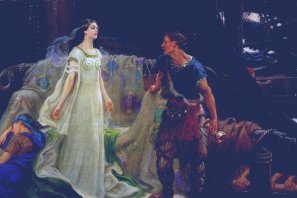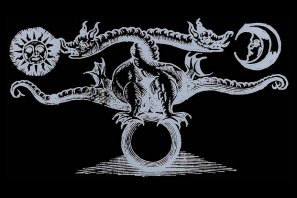Otto Maier’s secret texts. Is there more than meets the eye? Wali – Wili – Widi – Widar. In Eddic mythology Odin is avenged on the Fenris wolf by Widar. Wili is named alongside We as Odin‘s or Wotan’s brother. According to the third poem in the Poetic Edda, the vafthrudnismal (Vafþrúðnismál). Widar and Wali (who avenges Baldur and Hödur) rule over the sanctuary once Surtur’s flames have gone out. He is also called Ali...
Intimacy. In our culture, there is an excessive concentration on the notion of relationship. People talk incessantly about relationships. It is a constant theme on television, film, and in the media. Technology and media are not uniting the world. They pretend to provide a world that is internetted, but in reality, all they deliver is a simulated world of shadows. Accordingly, they make our human world more anonymous and lonely. In a world where the...
Samhain is a time to journey to the dark side. Now that the days shorten quickly, we journey to the shadow lands to commune with the ghosts of our past. Visiting what has died in us, express our longing and loss, and through that expression find healing … Third Festival The last days of Octobre the Third Festival of the Harvest also known as Festival of the Dead, All Saints, Ancestors Night, Feast of the Dead, Hallowmas, All Hallow’s Eve, […]...
An enigmatic depiction of the golden fleece quest: an Athenian Red-figure cup discovered in 1834 and attributed to the Athenian painter Douris (c. 480 BC) shows in its interior the goddess Athena who watches as a huge serpent disgorges a man, alive. Behind them is a tree with a ram’s skin in its branches. These clues assure us that the hero is Jason. The artist has also taken care to label him (the name is...
In Sanskrit, skull cups are known as kapala, and they are generally formed from the oval section of the upper cranium. They served as libation vessels for large numbers of deities, which were mostly wrathful. However, they are also seen with gods such as Padmasambhava (India), who holds the skull cup, which is described as holding an ocean of nectar that floats in the longevity vase. This Elixir was at the heart of many secret...
The anima as a friend or soror mystica (mystical sister) has always played a great role in history. In the “cours d’amour” (courts of love) of René d’Anjou she even takes precedence over the wife. The term maîtresse actually means mistress or master. In the Middle Ages, for example, the worship of the anima led to courtly love, in which the knight was committed to his lady and was at her service. In later history we know of women such […]...
The School of Gnosticism was divided into two major parts, commonly called the Syrian Cult and the Alexandrian Cult. These schools agreed in essentials, but the latter division was more inclined to be pantheistic, while the former was dualistic. While the Syrian cult was largely Simonian, the Alexandrian School was the outgrowth of the philosophical deductions of a clever Egyptian Christian, Basilides by name, who claimed to have received his instructions from the Apostle Matthew. Like Simon...
The name of Hermes, whether or not qualified as Trismegistus, henceforth served as guarantee or signature for a host of esoteric books on magic, astrology, medicine, etc., throughout the Middle Ages, and this despite the fact that, with the exception of the Asclepius, the Corpus Hermeticum was unknown. Picatrix At the same time, an inspired imagery unfolded in both Latin and Arabic literature in a succession of “visionary recitals” (as Henry Corbin calls them), constellated...
In every varieties of the Arthurian legend, the traditional reality of Arthur (who supposedly was the Warrior King of the Nordic Cimres as they definitely battled against the Anglo-Saxons between the 5th and sixth century C.E.), is less important in comparison to the aspect according to which we are led to see in his kingdom a sense of the fundamental regal function purely linked to the Hyperborean tradition, to the point that it obtained a value with symbolic together with […]...
Plato, as the speaker Timaeus, refers to the Demiurge frequently in the Socratic dialogue Timaeus, circa 360 BC. The Demiurge as the entity who “fashioned and shaped” the material world. The Demiurge is the craftsman. The term demiourgos or craftsman is itself surprising – one might expect such a character to be rather grandly titled Nous or Logos. At Athens, the craftsman was either a slave or if free, one who acquired a certain stigma...
In the annals of Northern Europe during the Renaissance, amidst the flourishing of Hermeticism, Kabbalah, and Medieval magic, emerges an intriguing figure whose life and work spanned the realms of pre-Christian mythology and esoteric Renaissance knowledge. Johannes Thomae Agrivillensis Bureus, known simply as Johannes Bureus (1568-1652), embodies this unique fusion of disparate yet intertwined traditions. Despite the scarcity of information about him, his contributions to the study of Nordic mythology and runology, alongside his engagement...
For those who are into the multi-level and the different themes of the Maier Files already noted that one of the themes associates with the Grail Quest, the hidden knowledge and the search for this power. The quest of the Golden Fleece and the Argonauts has always been in connection with the quest of the Holy Grail. And yes, also this tale has plenty layers or levels. In Greek mythology, the Golden Fleece (Greek: χρυσόμαλλον δέρας chrysómallon déras) is the […]...













